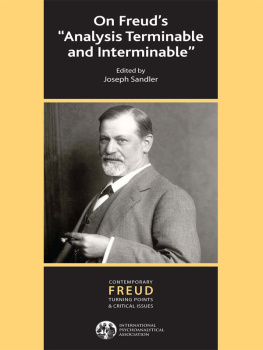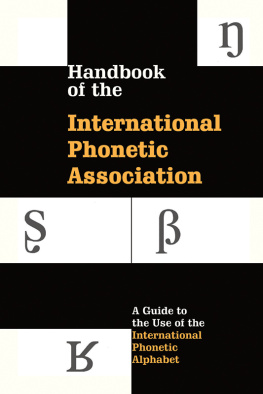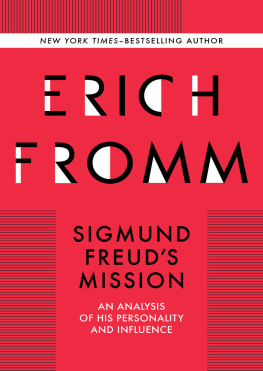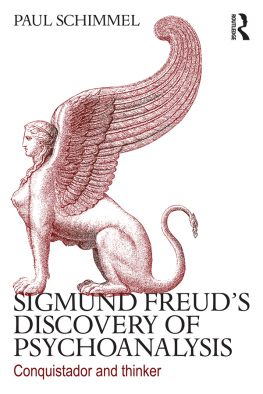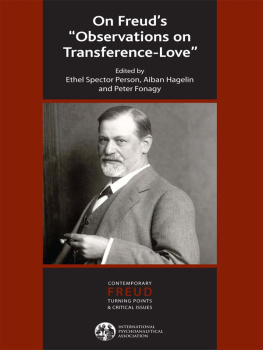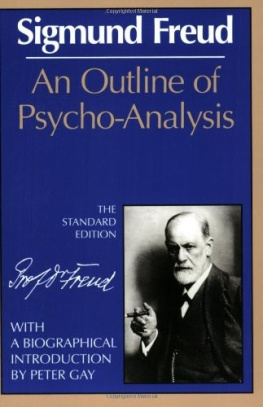International Psycho-Analytical Association. - On Freuds Analysis terminable and interminable
Here you can read online International Psycho-Analytical Association. - On Freuds Analysis terminable and interminable full text of the book (entire story) in english for free. Download pdf and epub, get meaning, cover and reviews about this ebook. City: London, year: 2013, publisher: Karnac Books, genre: Romance novel. Description of the work, (preface) as well as reviews are available. Best literature library LitArk.com created for fans of good reading and offers a wide selection of genres:
Romance novel
Science fiction
Adventure
Detective
Science
History
Home and family
Prose
Art
Politics
Computer
Non-fiction
Religion
Business
Children
Humor
Choose a favorite category and find really read worthwhile books. Enjoy immersion in the world of imagination, feel the emotions of the characters or learn something new for yourself, make an fascinating discovery.
- Book:On Freuds Analysis terminable and interminable
- Author:
- Publisher:Karnac Books
- Genre:
- Year:2013
- City:London
- Rating:4 / 5
- Favourites:Add to favourites
- Your mark:
- 80
- 1
- 2
- 3
- 4
- 5
On Freuds Analysis terminable and interminable: summary, description and annotation
We offer to read an annotation, description, summary or preface (depends on what the author of the book "On Freuds Analysis terminable and interminable" wrote himself). If you haven't found the necessary information about the book — write in the comments, we will try to find it.
On Freuds Analysis terminable and interminable — read online for free the complete book (whole text) full work
Below is the text of the book, divided by pages. System saving the place of the last page read, allows you to conveniently read the book "On Freuds Analysis terminable and interminable" online for free, without having to search again every time where you left off. Put a bookmark, and you can go to the page where you finished reading at any time.
Font size:
Interval:
Bookmark:
A New Look at Freud's Analysis Terminable and Interminable

JACOB A. ARLOW
It would be difficult to imagine a psychoanalytic experience more stimulating or thought-provoking than rereading Freud's Analysis Terminable and Interminable and examining from our current perspective the many important issues it raises. The questions Freud posed then are fundamental to controversies in psychoanalysis to this very day. Some of the answers he proposed seem outdated and patently incorrect, while others are penetratingly perceptive, anticipating major lines of development for psychoanalytic technique.
It should be recalled that, only a few years before he wrote this paper, Freud had revised his concept of the psychic apparatus in a radical way. He had ceased trying to understand mental phenomena from a predominantly topographic point of view in favor of a structural approach, an approach which emphasized the interplay of persistent, organized forces in the mind. Whereas the topographic model stressed the pathogenic significance of what was repressed into the system Ucs, the structural model stressed the role of intrapsychic conflict and compromise formation. Obviously, it was not easy for Freud, at the end of his days, to make a clean and decisive break with a model of conceptualization which for so many years he had found so fruitful. In The Ego and the Id (1923), for example, he stated that henceforth he would be using the terms conscious and unconscious in a purely descriptive, rather than systematic, way. Nevertheless, in An Outline of Psychoanalysis (1940), he reverted to discussions of the characteristics of the systems Ucs, Pcs, and Pcpt-Cs. On reexamining Analysis Terminable and Interminable. it is both interesting and instructive to observe how concepts from the two different frames of reference are used side by side, sometimes in a contradictory fashion.
In essence Analysis Terminable and Interminable is an essay on psychoanalytic technique. Freud asks: How can we make the process of analysis shorter? How can we make it more effective? Should we be able to protect the analysand against recurrence of his or her illness? Would it be possible to make an analysand immune to psychological illness in general? Obviously, before these questions can be addressed, one must confront the issue of the nature of the pathological process. The rationale of any technique clearly must relate to how it goes about correcting the pathological process and its effects. It is at this point that the conceptual model becomes important. In the topographic theory, the system Ucs is the great reservoir or container of the instinctual drives. According to this theory, when discharge of the instinctual drives is blocked by repression, psychological illness supervenes. We can recognize in this formulation the lingering effects of an actual theory of pathogenesis. The implications for technique follow quite logically. The goal of technique becomes one of overcoming repression. Its tangible result is the recollection of an event that had been forgotten.
Freud states this quite explicitly. In discussing the possibility of a person becoming completely analysed, Freud says, It is as though it were possible by means of analysis to attain to a level of absolute psychical normalitya level, moreover, which we could feel confident would be able to remain stable, as though, perhaps, we had succeeded in resolving every one of the patient's repressions and in filling in all the gaps in his memory (pp. 21920, emphasis added). Elsewhere, Freud says, Thus the real achievement of analytic therapy would be the subsequent correction of the original process of repression, a correction which puts an end to the dominance of the quantitative factor (p. 227). In actual practice, as Freud noted in Constructions in Analysis (1937), this hardly ever happens, and it becomes necessary to conjecture, or to reconstruct missing links in the personal history. Several authors (Esman 1973, Arlow 1978, Blum 1979) have noted that patients who have had long and repeated exposure to the primal scene, for example, do not recover the memory, even after convincing reconstruction and excellent therapeutic results. In other words, undoing repression, as exemplified by the recollection of forgotten memories, is not in itself the summum bonum of psychoanalytic technique.
In concentrating on undoing repression during therapy, Freud reached certain conclusions about the role of the defense mechanisms that in many respects run counter to our current views. He says, The adult's ego, with its increased strength, continues to defend itself against dangers which no longer exist in reality; indeed, it finds itself compelled to seek out those situations in reality which can serve as an approximate substitute for the original danger, so as to be able to justify, in relation to them, its maintaining its habitual modes of reaction. Thus we can easily understand how the defensive mechanisms, by bringing about an ever more extensive alienation from the external world and a permanent weakening of the ego, pave the way for, and encourage, the outbreak of neurosis (p. 238). Later in the same section, Freud adds, The crux of the matter is that the defensive mechanisms directed against former danger recur in the treatment as resistances against recovery. It follows from this that the ego treats recovery itself as a new danger (p. 238, emphasis in the original).
However, it runs counter to the concept of the ego as an agency of adaptation (Hartmann 1939) to posit the ego seeking out new situations as approximate substitutes for an original danger in order to rationalize maintaining pathogenic defense mechanisms. It is much more in keeping with clinical experience to view the situation in the following light: Because of the persistent effect of unconscious fantasy wishes, reality tends to be misperceived, misinterpreted, and misresponded to in terms of these unconscious fantasies. Thus, the patient responds to an external situation in terms that would be appropriate in response to his unconscious fantasy. For example, some phobic patients behave as if entering a tunnel were something dangerous to do, because unconsciously they are responding to a fantasy of entering the mother's body, within which a dangerous rival lurks, ready to destroy them. Situations in reality that are in some way comparable to or reminiscent of unconscious fantasies and traumatic incidents tend to evoke and reactivate such fantasies and the conflictual wishes associated with them, and thereby also evoke the need to fend off the dangers connected with those wishes (Arlow 1969). Only from the most superficial, phenomenological point of view can it be said that the ego treats recovery itself as a new danger. In the unconscious portion of the ego, it is the threatened confrontation with the derivatives of the id impulses that signals the need for defensive activity.
These ideas are, of course, Freud's own, subordinated at the time to his emphasis on the importance of recollection in the therapeutic process. In much the same way, Freud referred to transference as a resistance. Insofar as transference substitutes repetition for recollection, this is correct. Transference is a resistance to remembering. At the same time, however, transference does advance the analytic effort. Actually, transference is an example of compromise formation. It is a dynamically determined derivative of the unconscious instinctual conflict. Transference allows for a certain amount of instinctual discharge and gratification, but it does so through a process of displacement from the primary object to the analyst, from the past onto the present. Like a symptom, a dream, or a parapraxis, transference is a distorted representation of a persistent, conflictual, unconscious fantasy. The analysis of the transference, like the analysis of defenses, serves the purpose of bringing into clear expression the hierarchically layered derivatives of the unconscious wish.
Next pageFont size:
Interval:
Bookmark:
Similar books «On Freuds Analysis terminable and interminable»
Look at similar books to On Freuds Analysis terminable and interminable. We have selected literature similar in name and meaning in the hope of providing readers with more options to find new, interesting, not yet read works.
Discussion, reviews of the book On Freuds Analysis terminable and interminable and just readers' own opinions. Leave your comments, write what you think about the work, its meaning or the main characters. Specify what exactly you liked and what you didn't like, and why you think so.

